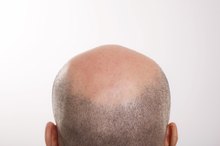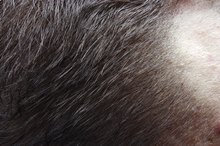Medical Reasons for Eyebrow Loss
Eyebrow loss, also known as superciliary madarosis, can occur with a variety of medical conditions. Madarosis can affect one or both eyebrows with partial or complete hair loss. Infections, chronic skin disorders, hormone disturbances, autoimmune diseases and medications are among the many medical reasons for eyebrow loss. In most cases, identification and treatment of the underlying condition leads to regrowth of the eyebrows. Permanent eyebrow loss can occur with disorders that permanently damage the hair follicles.
Chemotherapy
Some cancer chemotherapy drugs cause temporary hair loss, which affects all body hair. Along with the loss of scalp hair, people undergoing chemotherapy also commonly lose their eyebrows and eyelashes. Chemotherapy drugs that frequently cause:
- hair loss include paclitaxel
- 5-fluorouracil
- carboplatin
- cisplatin
- actinomycin-D
- bleomycin
- vincristine
- cyclophosphamide
- altretamine
- etoposide
- docetaxel
- doxorubicin
Hair loss typically begins 2 to 3 weeks after the start of chemotherapy. Lost eyebrow hair regrows in the weeks to months following completion of treatment.
- Some cancer chemotherapy drugs cause temporary hair loss, which affects all body hair.
- Along with the loss of scalp hair, people undergoing chemotherapy also commonly lose their eyebrows and eyelashes.
Hypothyroidism
Why Don't Some People Have Eyelashes?
Learn More
Hypothyroidism, or an underactive thyroid gland, adversely affects scalp and body hair growth. Thinning of the eyebrows can be a late sign of hypothyroidism. Other symptoms of hypothyroidism include chronic fatigue, weakness, constipation, weight gain and skin dryness. Treatment of hypothyroidism with thyroid hormone replacement medication typically leads to regrowth of lost eyebrow hair.
- Hypothyroidism, or an underactive thyroid gland, adversely affects scalp and body hair growth.
- Thinning of the eyebrows can be a late sign of hypothyroidism.
Atopic Dermatitis
Atopic dermatitis is a form of eczema that causes red, itchy patches of skin. Involvement of the skin around the eyes can lead to swelling, skin inflammation and loss of the eyebrow hairs, according to the National Institute of Arthritis and Musculoskeletal and Skin Diseases 2. Skin-irritating cosmetics and soaps may aggravate atopic dermatitis 2. The eyebrows often regrow when the condition becomes inactive.
Alopecia Areata
Skin Problems That Cause Eyebrow Loss
Learn More
Alopecia areata is a chronic autoimmune disease in which the immune system erroneously attacks the hair follicles, causing inflammation and temporary hair loss 1. Any hair-bearing skin site can be affected by alopecia areata, including the eyebrows 1. Treatment commonly involves corticosteroid injections into the site of eyebrow loss. Eyebrow hairs usually grow back, but may be a different color or texture than the lost hairs.
Other Medical Reasons
Hansen's disease, also known as leprosy, is an infection of the skin and nerves caused by the bacterium Mycobacterium leprae. The disease often affects the skin of the eyebrow region, leading to loss of sensation and permanent loss of the eyebrow hairs. There are numerous other rare and uncommon causes of eyebrow hair loss, including vitamin A toxicity, nutritional disorders and other dermatological disorders. If you experience loss of eyebrow hair, see your doctor to evaluate the cause and to discuss a treatment plan.
Reviewed by Kay Peck, MPH RD
- Hansen's disease, also known as leprosy, is an infection of the skin and nerves caused by the bacterium Mycobacterium leprae.
- There are numerous other rare and uncommon causes of eyebrow hair loss, including vitamin A toxicity, nutritional disorders and other dermatological disorders.
Related Articles
References
- OncoLink: Hair Loss/Alopecia
- National Institute of Arthritis and Musculoskeletal and Skin Diseases: Atopic Dermatitis
- American Academy of Dermatology: Alopecia Areata
- International Journal of Trichology: Madarosis: A Marker of Many Maladies
- Kim I-R, Cho J-H, Choi E-K. Perception, Attitudes, Preparedness and Experience of Chemotherapy-Induced Alopecia among Breast Cancer Patients: a Qualitative Study. Asian Pacific Journal of Cancer Prevention. 2012;13(4):1383-1388. doi:10.7314/apjcp.2012.13.4.1383
- Watanabe T, Yagata H, Saito M. A multicenter survey of temporal changes in chemotherapy-induced hair loss in breast cancer patients. PLoS One. 2019;14(1):e0208118. Published 2019 Jan 9. doi:10.1371/journal.pone.0208118
- Fingeret M, Teo I, eds. Body Image Care for Cancer Patients. Oxford Medicine Online. 2018. doi:10.1093/med/9780190655617.001.0001
- Dua, P.; Heiland, M.; Kracen, A.; et al. "Cancer-related hair loss: a selective review of alopecia research literature." Psycho-Oncology. November 2015; 26(4):438-443.
Writer Bio
Dr. Tina M. St. John owns and operates a health communications and consulting firm. She is also an accomplished medical writer and editor, and was formerly a senior medical officer with the U.S. Centers for Disease Control and Prevention. St. John holds an M.D. from Emory University School of Medicine.









